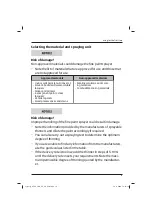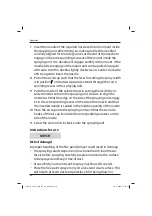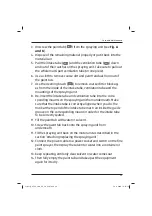
14
Safety
h) Do not allow yourself to be lulled into a false sense of securi-
ty and do not ignore the safety regulations covering electric
power tools, even if you are familiar with the power tool af-
ter having used it many times.
Carelessness can lead to serious
injuries in just a fraction of a second.
4. Using and handling the power tool
a) Do not overload your power tool.
Use the correct electric tool
for the job in hand. The correct tool will enable you to work better
and more safely within the specific performance range.
b) Do not use an electric power tool if the switch is defective.
An
electric power tool that cannot be switched on or off is dangerous
and must be repaired.
c) Pull the plug out of the socket and/or remove the remo-
vable battery pack before making any adjustments to the
tool, changing plug-in tool parts or putting the power tool
down.
These precautions will prevent the power tool starting
accidentally.
d) Keep unused electric tools out of the reach of children.
Do
not allow people who are not familiar with the power tool or who
have not read these instructions to use the power tool. Electric
tools are dangerous if they are used by inexperienced people.
e) Look after power tools and plug-in tools with care.
Check that
moving parts function correctly and do not jam, and whether any
parts are broken or damaged such that they adversely affect the
function of the power tool. Have damaged parts repaired before
you use the power tool. Many accidents are caused by poorly
maintained electric tools.
f) Keep cutting tools sharp and clean.
Carefully maintained cut-
ting tools with sharp cutting edges will jam less and are easier to
control.
g) Use the power tool, plug-in tools, etc. as set out in these
instructions.
Take account of the conditions in your work area
Layout_DS_FSS_500_EX_UK_SPK7.indd 14
Layout_DS_FSS_500_EX_UK_SPK7.indd 14
19.11.2020 15:15:28
19.11.2020 15:15:28















































